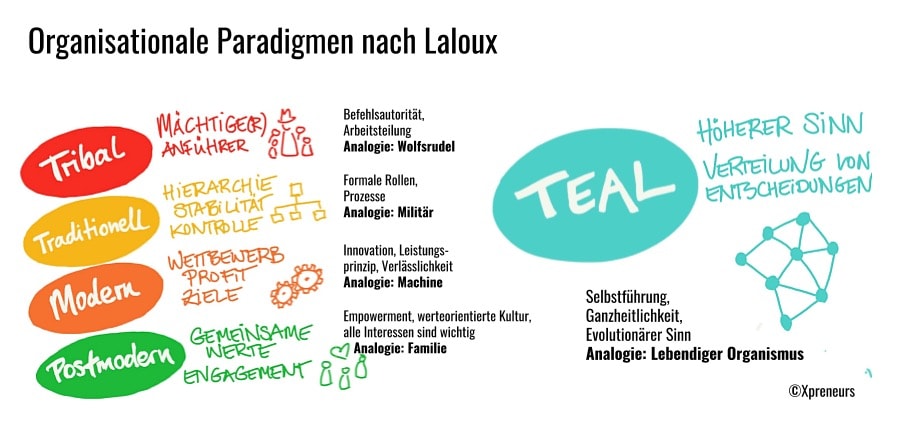It is not just about a new management idea. It is about implementing the latest scientific findings and understanding that every company, every organization is a living organism. Try to control all the processes of your body cells. You will fail and not stay in the market for long.
Professor Bruce Lipton showed that the nucleus of a cell is not the controlling brain, but that the membrane is much more important.
What does this mean for companies? Control by a patriarch, a board of directors that thinks it can make decisions for the laws of the world behind closed doors - sooner or later this will always fail. A planned economy, in whatever form, always fails. This also applies to us humans. Our brain is the limiting factor. It must not be the sole boss, because it can only recall the past and usually "thinks" in a left-brain linear way.
But life is a complex, dynamic process. This is also the great advantage that humans have over robots. Knowledge can be passed on. Experience, as the word says, cannot be taught, it has to be experienced. Wisdom is therefore becoming the new leadership skill.
I've always said: I don't believe in delegation. Actually, there is no such thing. Because delegation means passing on your own tasks. But in a good organization, everyone does their own thing. They also have responsibility for clearly defined tasks. Unfortunately, it is already normal today to outsource responsibility. (You can also listen to my PodCast episode Peace needs professionals).
I often mention the Graves model or Spiral Dynamics according to Dr. Beck. The Teal level requires 7th level awareness in order to be able to lead an organization integrally. Or, as Frédéric Laloux called it, to lead it with Teal competence.
Here is an article by Daniela Spielmann, in which she explains well what Teal is all about and why we at Win Win AG have been involved with Teal Consulting for some time and are now increasingly doing so:
Teal - Frédéric Laloux uses this term in his book "Reinventing Organizations", we hear that the future of work is teal, there is the Teal Camp and numerous other events to establish a "teal mindset" ... but what exactly is this teal thing?
If you talk to different people from different organizations today, you will always find a similar picture: rigid structures and strict and diverse hierarchical levels inhibit decision-making and the ability to react quickly to change. Both employees and managers are frustrated.
The reactions to this are creative. Organizations are trying to loosen structures and create spaces in which work is meaningful and potential is developed. The change initiated by digitalization and the changing environmental conditions of the 21st century is not the first of its kind. Throughout history, there have always been such changes that have led to new paradigms in society. Different lifestyles require different concepts of leadership, work distribution, roles and life design. The underlying human worldviews are expressed in different levels of human development and needs. In his book "Reinventing Organizations", Frédéric Laloux links these worldviews to work in organizations and describes various models of organizational paradigms. The following figure shows the metaphor and the main breakthroughs to the main stages of Laloux's model.

Teal or petrol refers to the integral evolutionary stage of Frédéric Laloux's model. The description of the teal paradigm is so far only a beginning description, as it is still too new to make conclusive statements about it. Today, modern performance-oriented and postmodern pluralistic organizations are (still) predominant, with the latter occurring even less frequently than modern performance-oriented organizations.
Laloux points out that although the various paradigms are presented in a stage model, this does not mean that earlier stages are "worse" than later ones. Rather, later stages are more complex. Each paradigm is appropriate for a specific context. As the same conditions still do not prevail everywhere in the world, most paradigms will continue to coexist for a long time to come. Likewise, organizations cannot simply be assigned to one paradigm. It is entirely possible for organizations to act according to different paradigms.
The ego plays a major role in today's working world. It determines our fears, goals and desires and thus leads to phenomena such as political considerations, the hoarding of information or a lack of authenticity in organizations. In order to take the step into the integral evolutionary paradigm (teal), the ego must be overcome in order to minimize precisely such phenomena and create more clarity, openness and trust. Furthermore, people who live according to the integral evolutionary paradigm have great confidence that everything will turn out well. Difficulties are seen as an opportunity to grow and learn. Decisions are made according to whether the decision fits in with our own convictions and developments and whether we are of benefit to the world or our organization as a result. The goal in life and at work is to be the true embodiment of ourselves, using our talents and calling to do something meaningful.
What does this mean in concrete terms for organizations at the integral evolutionary level?
The most important breakthroughs of evolutionary organizations are self-management, evolutionary sense and holism.
Self-management, or self-organization, means abolishing the traditional hierarchy. Instead, power is distributed equally among all members of an organization. Each member bears the responsibility and decision-making power for their own area. When making decisions, it is only necessary to ensure that the autonomy of other members is not interfered with or that someone's work is not hindered. The hierarchical pyramid is no longer a suitable structure for this. Organizational charts and job profiles are replaced by a circular structure and roles. These roles are not fixed and can always change or be relinquished. For self-management to work, it is essential that a culture of trust is created. Trust arises from the individual conviction that all members of the organization are benevolent people who always want to do the right thing.
Laloux explains the evolutionary sense in such a way that organizations are alive on their own and develop in a certain direction. The members of the organization should therefore not impose anything on the organization, but listen and understand what the organization wants to become and what meaning and purpose it wants to serve.
Wholeness should mean that people can come to work as their whole selves and do not have to hold back parts of themselves. Today, emotional, intuitive or spiritual aspects of work are seen as out of place. In evolutionary organizations, people should also bring these aspects to the table, as everyone is most effective as a whole self.
But wait a minute, this isn't really all that new, is it?
Laloux did not reinvent the world, he was just the first to systematically search for companies with new methods and organizational models. His model of organizational paradigms and his book "Reinventing Organizations" emerged from the findings of this study. Even before Laloux's book, there were already a number of concepts that pointed to teal organizations. The following references are not nearly an exhaustive presentation of all previous concepts, but only a selection by the author.
Laloux's model is directly related to Clare W. Graves' emergent, cyclical double helix model of human biopsychosocial development. It is a model with different levels whose stages are marked with colors. The guiding question in the development of Graves' model was what exactly constitutes a mentally healthy person. In their book "Spiral Dynamics", Don Edward Beck and Christopher C. Cowan applied Graves' model to management and leadership.
According to Fuchs (1999), the vital company also shows some signs of evolutionary organizations. In his book, he describes the change from the old security to a new type of security. The old security is created by fixed structures and control, such as the organization chart, job descriptions and management by instruction and control. The new security is created by promoting principles of self-organization, the creation of new structures that promote inner intelligence and the definition of processes as a chain of services rather than a sequence of activities. It should not be underestimated that employees also have to support some changes. They will become entrepreneurs and must learn to take responsibility. Hiding behind managers and their decisions is no longer possible. As virtually all employees will become managers, everyone will have to come to terms with power and how to deal with it.
Is all that glitters gold?
Of course, Laloux's book and his study are not above reproach either. His examples are rather one-sidedly positive, the data is often only based on interviews with the managing directors, there are no answers to many questions, and problems and failures are not discussed further. The description of the evolutionary sense also remains rather vague and raises the question of how an organization, not the people in the organization, should find its own way. But Laloux has made a valuable contribution and provides a nice overview of concrete practices in new forms of organization. His book inspires and motivates many to take a closer look at the subject. We are at the beginning of a new paradigm. Pioneering work is needed to enable a new way of working and living for us and future generations.
Perhaps you can now better understand where the journey is going. But as always, the same applies here: Reading a book or attending a workshop is not enough. You have to empower yourself to live Teal and implement Teal as an entrepreneur!
Dr. Ken West, co-founder of Teal Village, says: "Many people talk about Teal, but hardly anyone really understands it.
Together with his partners, he has now developed a system based on Ken Wilber's Integral Model and Dr. Don Beck's Spiral Dynamics that not only allows you to quickly understand how an organization can be adapted to Teal, but above all how to implement it easily. For me, Dr. Ken West's system is the missing link that I have been looking for for 10 years.
Even in my early KNACK points for business success in the 21st century, I called for cultural change and culture officers in companies who can cultivate the communication process. But how to implement this easily and with good quality remained an open question at the time. Dr. West solved it, and we are of course very proud to be working with him in this area from now on.
If you are interested, write to me directly: w.sonnenburg@win-win.ag
